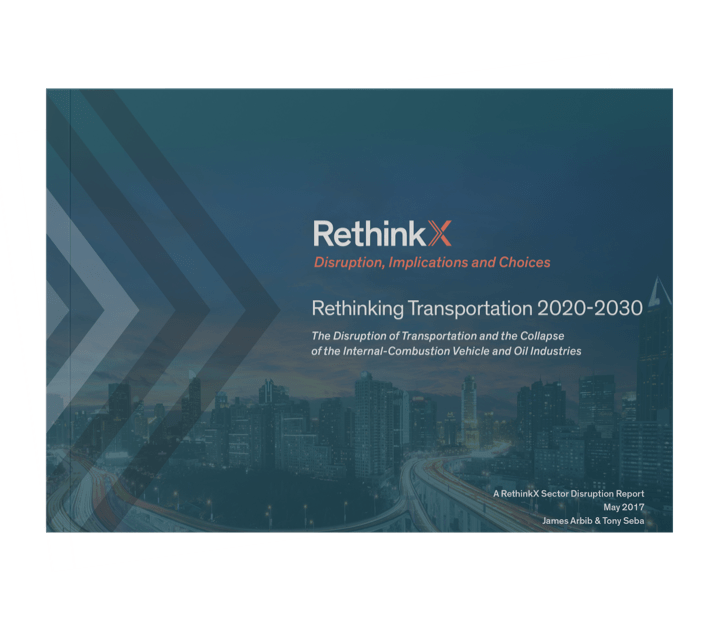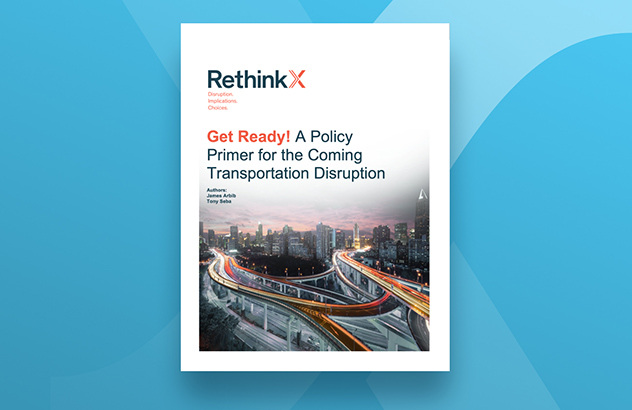Topic / Transportation / In-depth
Policy Considerations for the Future of Transportation

A new policy structure will help usher in an era of affordable personal mobility
The Disruption of Transportation
In Rethinking Transportation 2020-2030, RethinkX provided a detailed analysis of the convergence of autonomous vehicles, electric vehicles and ride-hailing platforms, and the resulting disruption of our transportation sectors.
The emergent business model, Transport-as-a-Service (TaaS), has the potential to change the transportation landscape, ending individual vehicle ownership and reshaping the world’s energy economy.
Our Policy Primer for the Coming Transportation Disruption explains why policymakers should support the TaaS transformation, as well as ways they can support its progress. It also shows how potential adverse consequences can be mitigated by foresight and planning.

The following considerations can help guide policymakers in this disruption:
Priority Considerations
Fast-track technology and testing, and remove barriers
Support pilots, trials and testing. The more autonomous electric vehicles (A-EVs) on the road, the faster the industry can progress. Lack of support risks losing jobs and technology to China. Address uncertainties around liability, insurance, cybersecurity, testing and permitting to preempt any issues before they begin.
Encourage competition, interoperability, open data and fair user fees
Encourage interoperability, open data and open programming interfaces and standards. This will increase competition amongst transportation service providers. It will enable innovators and entrepreneurs to develop new products, applications and business models that will create new jobs and further decrease the cost of transportation. Open standards could, for instance, allow A-EVs from different providers to “talk” to one another or the built infrastructure such as traffic lights or the grid.
Design underlying data infrastructure well
The data infrastructure underpinning shared transport services must enable interoperability, competition and innovation, while delivering privacy, security, and accountability and paying fair share for road use, congestion, pollution, and curb use.
Plan for job changes
TaaS will bring new opportunities but also job losses. These can be mitigated through investment, retaining and income support to keep the workforce and household incomes healthy as people transition to new jobs and industries.
Work across party lines to build support for TaaS
A-EVs are apolitical, offering a massive economic boost and health and environmental benefits for every household.
Protect people, not companies or industries
A-EVs have the potential to transform lives. As with all disruptions, every aspect of our lives and societies will be transformed. Decision-makers must act to protect people first and foremost.
Planning Considerations
Accelerate adoption to get mass benefits
Whole-system adoption is needed to get the maximum benefit from A-EVs. Clear, standardized rules are needed to clarify accident liabilities, requirements and testing frameworks and liability related to cybersecurity breaches. Designated curbside drop-off and A-EV-only lanes would also speed adoption.
Promptly tackle transit planning
TaaS vehicles can and should work with other forms of public transportation such as buses, biking and walking. Infrastructure planning should incorporate and encourage all forms in a holistic approach.
Address potential congestion problems with lower cost transportation
During the transformation of our transportation systems to TaaS, policies to increase vehicle occupancy and manage curb use will be necessary to reduce the higher demand that accompanies lower cost. Interoperable vehicles in fleets, operated for ridesharing, are key. Removing subsidies for parking would increase vehicle throughput.
Require data interoperability and shared-ride fleets
The data infrastructure for shared transport services must be sufficiently open to enable interoperability, competition and innovation, while delivering privacy, security and accountability. Shared fleets and insulated data sharing will increase safety, while ensuring that vehicle maintenance and software upgrades are monitored and managed by professionals, that autonomous travel is available to all, and will help and that supply issues are addressed early. This will maximize the efficiency of vehicles and roads and minimize undue costs for the public sector.
Develop widespread integrated connectivity for seamless travel
Encourage all transportation services to be integrated and coordinated across vehicles, modes, operators and geographies. This depends upon ubiquitous wireless access and entails thoughtful system planning, physical connections, a single fare payment structure and combined mobility information.
Replace revenues with fair share for road and curb use, congestion and pollution
Lost government revenues from vehicle ownership and parking must be replaced. Revenues should be based on vehicle miles, not passenger miles. This will encourage shared riding and discourage empty vehicle travel.
Provide tangible signals: Incorporate TaaS into infrastructure and urban planning
Begin planning for the transport modes, uses and public users of the future. Considerations include the curb space TaaS will need, repurposing parking and road space, and readying for TaaS in other areas. Reexamine parking requirements, policies for curb space, lanes dedicated to A-EVs, and road striping policies. For instance, transportation planners should encourage higher vehicle utilization (vehicles that drive more miles each day and rarely use parking infrastructure) rather than higher occupancy in low utilization vehicles (vehicles that are parked most of the day).
Plan for cities and mobility together. Engage the public in a supportive, listening space
To demonstrate the benefits of TaaS and the positive changes it can bring, invest in public education and opportunities to codesign nodes, pick-up spaces and other community improvements. Be deliberate in planning for sprawl or density, and ensure planning for cities and mobility are undertaken together.

Featured Report
Uncover the Transportation Disruption in more depth
Download our Rethinking Transportation report










-min-1.png?width=732&name=Copy%20of%20Website%20imagery%20-%20Featured%20Image%201200x628%20(6)-min-1.png)




